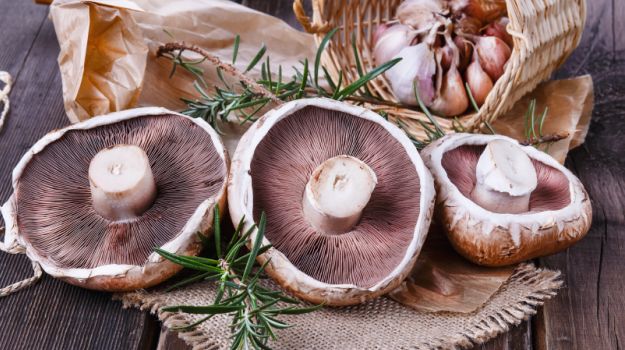There's another myth that assails the little mushroom, and that is the perception that it is a 'foreign' food item. Several mushrooms certainly are, but across India, for instance in Karnataka, you'll find hundreds of indigenous varieties, a few of which are consumed locally. Plus, since mushrooms are not very hard to grow, mushroom farms have (pardon the pun) mushroomed across the country, especially in the North East, which has the perfect climate to grow them. In Assam, the Mushroom Development Foundation drew in various small farmers, through their popular mushroom-growing initiatives, an initiative that also provided women with a much more tenable means of livelihood. Foraging for mushrooms is common enough to warrant regional newspaper articles, warning about poisonous mushrooms.

Image credit: Istock
Morels
Of course, the most famous of all Indian mushrooms is the mighty morel, that grows in Jammu & Kashmir, and Uttaranchal. The spongy-capped gucchi is the most expensive mushroom in India, and is available in both fresh and dried versions. They mostly appear during March to May, which in Kashmir, is when the snows melt and rain falls. Usually picked by the Gujjars, the gucchi is then sold at astronomical prices. In Delhi's INA Market, some of them can cost up to Rs 25,000 for a kilo! The honeycombed gucchi has a. intense musky, woody aroma and flavour, which pairs well with rice - the famous Kashmiri gucchi pulao is perhaps the perfect way to eat it.

Image credit: Istock
Button Mushrooms
Unfortunately, in Mumbai, it's quite hard to get one's hands on the morel, and we have to make do with the wee button mushrooms, white or tan in colour, they are perhaps the easiest to cultivate, which explains their proliferation across bhajiwala's stalls across the city, through the year. A pity, because they are the least flavourful of all mushrooms, and I can only stomach them when cooked into a bhaji, or crumb fried.
Portobello
The portobello may sound fancy, but it is actually just a grown up version of the button mushroom. The button mushroom is a baby, a pale, immature version of the hulking portobello, which is flatter, larger and tan-coloured. Many people don't eat the stem; quite often, it is sold without it entirely. In India, one of the companies that grows it is Weikfield, under their brand Eco Valley - their website even offers two recipes for it i.e. mushroom soup, and paneer mushroom methi. I like the portobello's deep, earthy flavour though, so I usually just tend to grill or roast them in the oven with a smidgen of olive oil. They're also excellent in risottos, perfuming the entire dish with their intense funk.

Image credit: Istock
Oyster Mushrooms
Oyster mushrooms are grown more widely in India than you might realise. They turn up in the North East, especially Assam, and come all the way south to Kerala. Oyster mushrooms are possibly names because they look a little like oysters or clams, with a delicate frill edging. They're quite meaty on their own, and I like them tossed in a pasta dish.
Shiitake
The little shiitake is usually found in Chinese restaurants around the country, mostly in their dried form. The reconstituted version tastes a little rubbery, but it is fairly versatile, lending itself to stir fries, congees, noodle soups, pasta dishes, even pizza toppings. If you're reconstituting the dried shiitake in hot water, try using the leftover liquid as a base for soup, or a marinade.
Enoki
These are beautiful, pallid shards, thin stalks with a crunchy mouthfeel. They grow in winter, the hardy little things, but have a sweet, gentle flavour. Try them in a quick stir fry or as a side to white fish.

Image credit: IstockMushroom Recipes
Fried Button Mushrooms
This is how I usually push the insipid-tasting button mushrooms to another level.
Button mushrooms 350g
Eggs 3, large
Breadcrumbs 3 cups
Oil, to deep-fry
Parsley, thyme, rosemary
Pepper and salt, to seasonMethod:
- Chop up the herbs finely. If you are not using fresh herbs, and instead using the flakes etc, then use a smaller quantity, as they flavour may be too intense and concentrated. Mix them with pepper and salt, and the breadcrumbs.
- Put the oil to heat in a kadhai, and meanwhile, lightly beat the eggs.
- Dredge each mushroom through the egg batter, then douse in the breadcrumb mixture, tossing and turning until the crumbs have adhered properly.
- Fry the mushrooms in batches in the hot oil, taking care not to over stuff the kadhai, so the mushrooms don't cling to each other. Drain off the oil on a paper, season lightly, and serve with chilli or tomato sauce.
Creamy Portobello Mushrooms
Portobello mushrooms 2 or 3, depending on size
Onions 1/2 cup, minced
Salt and pepper, to season
Garlic 5 cloves, peeled and minced
White wine 1/2 cup
Cream 1/2 cup
Oil, to cook
Method:
- Cook the onions and garlic to a lightly-oiled pan, and cook until onions soften. In the meantime, chop the mushrooms roughly, and add to the pan.
- Cook for another five minutes, stirring frequently.
- Add the white wine, cooking until about half has evaporated.
- Then pour in the cream, and simmer until the sauce has thickened a little. Serve with pasta.






